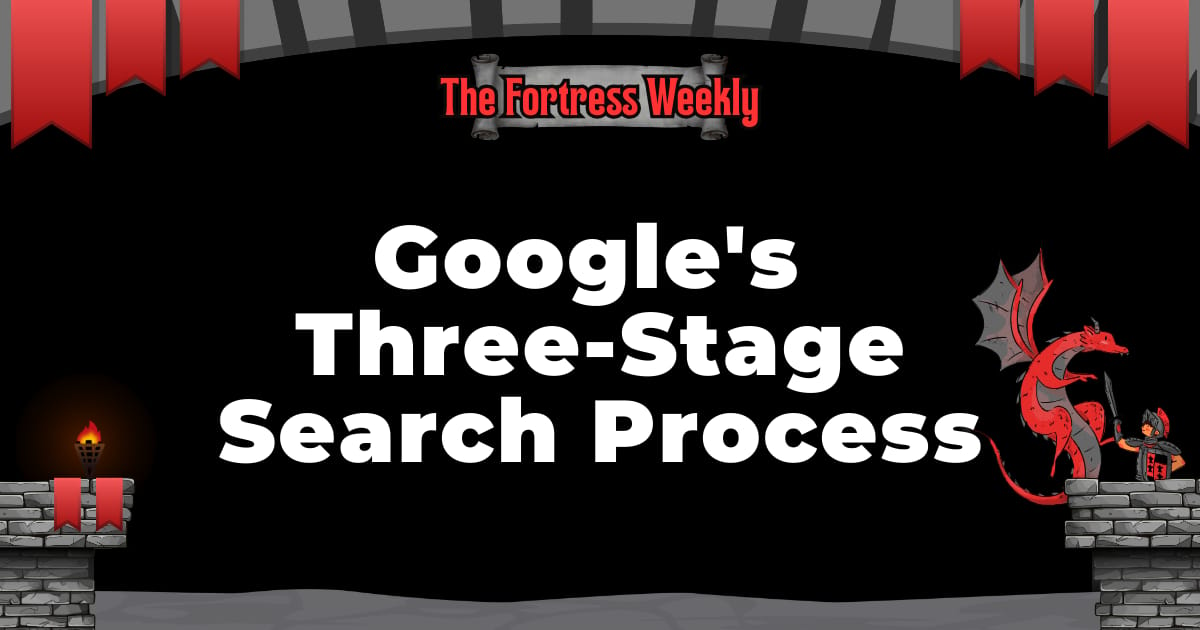🏰 THE FORTRESS WEEKLY
Issue #1 | Technical SEO | 4-minute read
Good morning, SEO warrior.
In today's newsletter, we're going to decode Google's Three-Stage Search Process. The secret lies in understanding that every ranking opportunity depends on mastering crawling, indexing, and serving - the invisible pipeline that determines whether your content gets discovered, understood, and ranked.
You'll learn how to optimize your website for each stage of Google's search process and leverage the latest crawler data to maximize your rankings. We'll reveal why 96% growth in Googlebot crawling activity means bigger opportunities for sites that understand the process.
Let's fortify your rankings! 👇

Algorithm Intel
Master Google's three-stage process to transform crawl budget into ranking dominance
Why Google's Search Pipeline Is Your Secret Weapon
Google processes over 5 trillion searches annually, but your content must survive three critical stages before it can capture any of that traffic. While most SEOs focus on keywords and links, the real ranking advantage comes from optimizing your site's journey through Google's crawling, indexing, and serving pipeline.

The Data Behind Google’s 3-Stage Process
Why Google's Pipeline Determines Your Rankings
Google's search process operates through three distinct stages: Crawling (discovery), Indexing (understanding), and Serving (ranking). According to Google's official documentation, not all pages make it through each stage - creating massive opportunities for optimized sites.
Cloudflare's 2025 research study revealed that Googlebot crawling activity increased by 96% from May 2024 to May 2025, with peak crawling traffic reaching 145% higher than the previous year. This means Google is hungry for more content—if your site can efficiently guide Googlebot through all three stages.
Key Finding: Googlebot crawls most sites once every few seconds and fetches up to 15MB of HTML per page, but only 0.63% of users click beyond the first page of results.

Case Study Breakdown
How Smart Sites Dominate Each Stage
Stage 1 - Crawling Optimization: Sites that understand Google's crawl budget see dramatic improvements. Google's Search Console data shows that sites serving critical resources from the same domain get crawled more efficiently, with faster page performance due to reduced connection overhead.
Stage 2 - Indexing Success: Google's indexing process analyzes content and determines canonical pages. Research shows that pages with clear content structure, proper metadata, and technical optimization have significantly higher indexing success rates.
Stage 3 - Serving Excellence: The top organic result earns a 22.4% CTR on mobile, dropping to 13% for position 2 and 10% for position 3, while the top 3 results capture over 45% of all clicks.
"Google's crawlers are constantly at work to ensure the data in the index stays up to date. Sites that optimize for all three stages see the most consistent ranking improvements." - Google Search Documentation

Your Action Plan
How To Optimize For Google's Three-Stage Process
Instead of generic technical SEO optimization:
<!-- Generic approach -->
<title>Products | Company Name</title>
<meta name="robots" content="index,follow">Apply Three-Stage Optimization to your technical foundation:
<!-- Three-stage optimized approach -->
<title>Premium Solar Panels - 25 Year Warranty | SolarTech Pro</title>
<meta name="robots" content="index,follow,max-image-preview:large">
<link rel="canonical" href="https://example.com/premium-solar-panels">
<script type="application/ld+json">
{
"@context": "https://schema.org",
"@type": "Product",
"name": "Premium Solar Panels"
}
</script>The impact: This optimization addresses all three stages - clear crawling signals through canonical tags, structured data for better indexing, and enhanced serving through rich snippets and large image previews.
Expected Results: Google case studies show the max-image-preview:large tag can increase Discover traffic by up to 333%, while canonical tags help "reduce Google crawling load" by prioritizing the main page version.

The 3-Step Implementation Guide
Step 1: Crawling Optimization Create XML sitemaps, optimize robots.txt, and ensure fast server response times. Googlebot crawls sites at a rate of once every few seconds, so technical performance directly impacts discovery.
Step 2: Indexing Enhancement Implement structured data, optimize content architecture, and ensure mobile-first compatibility. Google uses mobile-first indexing for 100% of new websites, making mobile optimization critical for indexing success.
Step 3: Serving Maximization Focus on user experience signals, Core Web Vitals, and content quality. Only 33% of websites pass the Core Web Vitals threshold, creating opportunities for optimized sites to dominate serving rankings.

The Fortress Takeaway
Google's three-stage process is the foundation of all SEO success. While others focus on surface-level tactics, understanding how Google discovers, processes, and serves your content gives you a systematic advantage. With Googlebot activity up 96% year-over-year, the sites that master all three stages will capture the majority of new ranking opportunities.
Master the pipeline, dominate the rankings. Focus on crawling efficiency, indexing clarity, and serving excellence.
Ready to Build Your SEO Fortress with Data-Driven Strategies?
Stop using outdated SEO tactics that Google ignores. Let's build campaigns that dominate rankings using proven strategies and real data.

